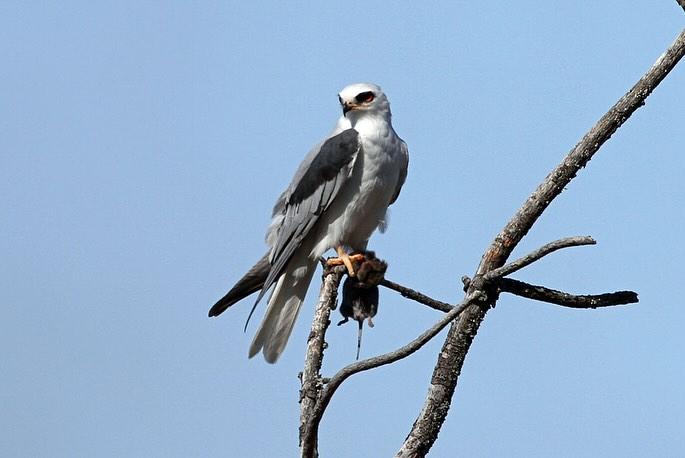
Species Spotlight: White-tailed Kite
The white-tailed kite (Elanus leucurus) is a fully protected species in California. This small hawk is slightly larger than a crow, about 14–17 inches in length with a wingspan of 35–40 inches. They typically weigh 250–380 g (8.8–13.4 oz). They have a pale gray body, black shoulders, a white head, and long tail. The wings are narrow and pointed. It has deep red eyes and a black beak. White-tailed kites get their name from a distinct hovering behavior known as “kiting.” They beat their wings while facing into the wind, giving the appearance of hanging in the air like a toy kite as they watch for prey moving on the ground.
White-tailed kite foraging habitat includes grasslands, open shrub, agricultural areas, wetlands dominated by grasses, fence rows and irrigation ditches (with residual vegetation) adjacent to grazed lands, riparian, oak woodlands, coastal sage scrub, and saltmarsh. The forage in almost any habitat with a dense population of voles (Microtus ssp.); its main prey in coastal Southern California is the California vole (Microtus californicus). It also preys on other small, diurnal mammals, and occasionally on birds, insects, reptiles, and amphibians.
The white-tailed kite breeding season is February to October, with the peak from May to August. Kites are monogamous through the breeding season, although some pairs remain together year-round. Nests of loosely piled sticks and twigs lined with grass, straw, or rootlets are located near open foraging areas and placed near the topes of oaks (Quercus ssp.), willows (Salix ssp.), or other tree stands from 20 -100 feet above ground. The average clutch is four or five eggs, with a range of three to six eggs. The female is responsible for incubation, which lasts about 28 days, and the young fledge in 35-40 days. During the incubation and nestling period, the male feeds the female, and supplies her with food to feed the young. Kits usually produce a single brood per breeding season but may occasionally have two broods.
As part of the monitoring program, The Nature Reserve has been conducting surveys to monitor the extent and general health of existing kite populations, identify potential stressors (e.g., urban-related predators, roads, trails, human harassment), and implement appropriate management actions to enhance, restore, and maintain grasslands, coastal sage scrub, chaparral, riparian, and woodland habitats within the HCP Planning Area. In 2024, a pair of white-tailed kites was recorded to successfully nest and fledge five nestlings in the Gobernadora Ecological Restoration Area (GERA).
